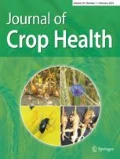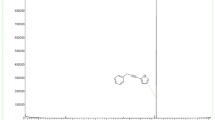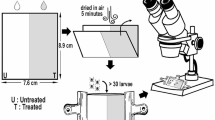Abstract
Crude plant extracts have been used as insecticides from ancient times. Keeping in view the environmental issues related to the excessive use of insecticides, plant derived products have been intensively investigated for their insecticidal potential. Alpinia galanga, a medicinal plant belonging to family Zingiberaceae exhibits a wide range of biologicial activities. Thus, the present study aims to evaluate the anti-insect potential of A. galanga against Spodoptera litura (Fab.), a polyphagous pest causing economic losses to many agricultural crops in India. Addition of A. galanga extracts to the larval diet adversely affected the survival and development of S. litura. Ethyl acetate extract was found to be the most effective causing 67.50% larval mortality at 2500 ppm and extending the development period by 12.73 days as compared to control. Purified compounds isolated from A. galanga viz. 1′-acetoxychavicol acetate and galangin exhibited more larvicidal activity in comparison to crude extracts. Both of the compounds also retarded the development of S. litura. The present study implies that A. galanga extracts have the potential to manage insect pests, although there is need to evaluate the field efficacy.
Zusammenfassung
Rohe Pflanzenextrakte werden seit der Antike als Insektizide verwendet. Angesichts der Umweltprobleme im Zusammenhang mit dem exzessiven Einsatz von Insektiziden werden Pflanzenextrakte intensiv auf ihr insektizides Potenzial hin untersucht. Alpinia galanga, eine zur Familie der Zingiberaceae gehörende Heilpflanze, weist ein breites Spektrum an biologischen Aktivitäten auf. Daher zielt die vorliegende Studie darauf ab, das insektenabwehrende Potenzial von A. galanga gegen Spodoptera litura (Fab.) zu evaluieren, einen polyphagen Schädling, der bei vielen landwirtschaftlichen Nutzpflanzen in Indien für wirtschaftliche Verluste sorgt. Die Zugabe von A.-galanga-Extrakten zur Nahrung der Larven beeinträchtigte das Überleben und die Entwicklung von S. litura. Der Ethylacetatextrakt erwies sich als am wirksamsten, da er bei 2500 ppm eine Mortalität von 67,50 % der Larven verursachte und die Entwicklungszeit im Vergleich zur Kontrolle um 12,73 Tage verlängerte. Aufgereinigte Komponenten, die aus A. galanga isoliert wurden, nämlich 1′-Acetoxychavicolacetat und Galangin, wiesen im Vergleich zu Rohextrakten eine höhere larvizide Aktivität auf. Beide Verbindungen verzögerten auch die Entwicklung von S. litura. Die vorliegende Studie deutet darauf hin, dass A.-galanga-Extrakte das Potenzial haben, Insektenschädlinge zu bekämpfen, auch wenn die Wirksamkeit in Feldstudien noch bewertet werden muss.






Similar content being viewed by others
References
Abdullah F, Subramanian P, Ibrahim H, Malek A, Nurestri S, Lee GS, Hong SL (2015) Chemical composition, antifeedant, repellent, and toxicity activities of the rhizomes of galangal, Alpinia galanga against Asian subterranean termites, Coptotermes gestroi and Coptotermes curvignathus (Isoptera: Rhinotermitidae). J Insect Sci 15:1–7
Arivoli S, Tennyson S (2011) Larvicidal and adult emergence inhibition activity of Abutilon indicum (Linn.) (Malvaceae) leaf extracts against vector mosquitoes (Diptera: Culicidae). J Biopestic 4(1):27–35
Arivoli S, Tennyson S (2012) Antifeedant activity of plant extracts against Spodoptera litura (Fab.) (Lepidoptera: Noctiduae). AEJAES 12(6):764–768
Arivoli S, Tennyson S (2013) Screening of plant extracts for oviposition activity against Spodoptera litura (Lepidoptera: Noctuidae). Int J Fauna Biol Stud 1:20–24
Barik BR, Kundu AB, Dey AK (1987) Two phenolic constituents from Alpinia galanga rhizomes. Phytochemistry 26:2126–2127
Charles DJ, Simon JE, Singh NK (1992) The essential oil of Alpinia galanga Willd. J Essent Oil Res 4:81–82
Chudiwal AK, Jain DP, Somani RS (2010) Alpinia galanga Willd.—An overview on phyto-pharmacological properties. IJNPR 1(2):143–149
Dadang, Riyanto S, Ohsawa K (1998) Lethal and antifeedant substance from rhizome of Alpinia galanga Sw. (Zingiberaceae). J Pestic Sci 23:304–307
Datta R, Kaur A, Saraf I, Singh IP, Kaur S (2019) Effect of crude extracts and purified compounds of Alpinia galanga on nutritional physiology of a polyphagous lepidopteran pest, Spodoptera litura (Fabricius). Ecotoxicol Environ Saf 168:324–329
Daubresse N, Francesch C, Mhamdi F, Rolando C (1994) A mild synthesis of coumaryl, coniferyl, sinapyl aldehydes and alcohols. Synthesis 4:369–371
De Pooter HL, Omar MN, Coolsaet BA, Schamp NM (1985) The essential oil of greater galanga (Alpinia galanga) from Malaysia. Phytochemistry 24:93–96
Devanand P, Rani PU (2011) Insect growth regulatory activity of the crude and purified fractions from Solanum melongena L., Lycopersicum esculentum Mill. and Capsicum annuum L. J Biopestic 4:118–130
Ekesi S (2000) Effect of volatiles and crude extracts of different plant materials on egg viability of Maruca vitrata and Clavigralla tomentosicollis. Phytoparasitica 28:1–6
Fand BB, Sul NT, Bal SK, Minhas PS (2015) Temperature impacts the development and survival of common cutworm (Spodoptera litura): simulation and visualization of potential population growth in India under warmer temperatures through life cycle modelling and spatial mapping. PLoS ONE 10:e124682
Hematpoor A, Liew SY, Chong WL, Azirun MS, Lee VS, Awang K (2016) Inhibition and larvicidal activity of phenylpropanoids from Piper sarmentosum on acetylcholinesterase against mosquito vectors and their binding mode of interaction. PLoS ONE 11:e155265
Isman MB (2006) Botanical insecticides, deterrents, and repellents in modern agriculture and an increasingly regulated world. Annu Rev Entomol 51:45–66
Isman MB (2008) Botanical insecticides: for richer, for poorer. Pest Manag Sci 64:8–11
Janssen AM, Scheffer JJC (1985) Acetoxyhydroxychavicol acetate, an antifungal component of Alpinia galanga. Planta Med 51:507–511
Jirovetz L, Buchbauer G, Shafi MP, Leela NK (2003) Analysis of the essential oils of the leaves, stems, rhizomes and roots of the medicinal plant Alpinia galanga from Southern India. Acta Pharm 53:73–82
Juntachote T, Berghofer E (2005) Antioxidative properties and stability of ethanolic extracts of holy basil and Galangal. Food Chem 92:193–120
Kaur A, Singh R, Dey CS, Sharma SS, Bhutani KK, Singh IP (2010) Antileishmanial phenylpropanoids from Alpinia galanga (Linn.) Willd. Indian J Exp Bio 48:314–331
Kaushik D, Yadav J, Kaushik P, Sacher D, Rani R (2011) Current pharmacological and phytochemical studies of the plant Alpinia galanga. Zhong Xi Yi Jie He Xue Bao 9:1061–1065
Khattak S, Shah HU, Ahmad W, Ahmad M (2005) Biological effects of indigenous medicinal plants Curcuma longa and Alpinia galanga. Fitoterapia 76:254–257
Koul O, Shankar JS, Mehta N, Taneja SC, Tripathi AK, Dhar KL (1997) Bioefficacy of crude extracts of Aglaia species (Meliaceae) and some active fractions against lepidopteran larvae. J Appl Entomol 121:245–248
Koul O, Singh G, Singh R, Multani J (2005) Bioefficacy and mode-of-action of aglaroxin A from Aglaia elaeagnoidea (syn. A. roxburghiana) against Helicoverpa armigera and Spodoptera litura. Entomol Exp Appl 114:197–204
Leatemia JA, Isman MB (2004a) Insecticidal activity of crude seed extracts of Annona spp., Lansium domesticus and Sandoricum koejape against lepidopteran larvae. Phytoparasitica 32:30–37
Lee SJ, Ando T (2001) Optically active 1‑acetoxychavicol acetate and its positional isomers: synthesis and repellent effect against adzuki bean weevil. J Pestic Sci 26:76–81
Lu J, Ma D (2015) Repellent and contact toxicity of Alpinia officinarum rhizome extract against Lasioderma serricorne adults. PLoS ONE 8:1–8
Matsuda H, Morikawa T, Managi H, Yoshikawa M (2003) Antiallergic principles from Alpinia galanga: structural requirements of phenylpropanoids for inhibition of degranulation and release of TNF‑a and IL‑4 in RBL-2H3 cells. Bioorgan Med Chem Lett 13:3197–3202
Pancharoen O, Prawat U, Tuntiwachwuttikul P (2000) Phytochemistry of the Zingiberaceae. In: Atta-ur-Rehman (ed) Studies in natural products chemistry, vol 23. Elsevier, Amsterdam, pp 797–865
Pandji C, Grimm C, Wray V, Witte L, Proksch P (1993) Insecticidal constituents from four species of Zingiberaceae. Phytochemistry 34:415–419
Paulraj MG (2001) Integration of intercrops and plant product on chosen groundnut pests management. St. Joseph’s College (Autonomous) Bharathidasan University, Trichy, Tamil Nadu, India (Ph.D thesis)
Pavela R (2016) History, presence and perspective of using plant extracts as commercial botanical insecticides and farm products for protection against insects—a review. Plant Prot Sci 52:229–241
Ranga Rao GV, Rupela OP, Rao VR, Reddy YVR (2007) Role of biopesticides in crop protection: present status and future prospects. Indian J Plant Prot 35:1–9
Rasoanaivo P, Wright CW, Willcox ML, Gilbert B (2011) Whole plant extracts versus single compounds for the treatment of malaria: synergy and positive interactions. Malar J 10:4
Sengottayan SN (2013) Physiological and biochemical effect of neem and other Meliaceae plants secondary metabolites against Lepidopteran insects. Front Physiol 4:359
Sharma R, Sohal SK (2013) Bioefficacy of quercetin against melon fruit fly. Bull Insectol 66:79–83
Singh A, Parasanth K, Ojha JK (1998) Antifeeding response of some plant extract against Spodoptera litura (Fab.) of groundnut. Indian J Appl Entomol 12:9–13
Singh KM, Singh MP, Sureja AK, Bhardwaj R (2012) Insecticidal activity of certain plants of zingiberaceae and araceae against Spodoptera litura F. and Plutella xylostella saunders in cabbage. Indian J Entomol 74:62–68
Sonkamble MM, Dhanorkar BK, Munde AT, Sonkamble AM (2000) Efficacy of indigenous plant extracts against Helicoverpa armigera (Hubner) and Spodoptera litura (Fabricius) under laboratory conditions. J Soils Crop 10:236–239
Sowmya SN, Calistus Jude AL, Deepa MA (2016) Anti-termite properties of four selected species of Zingiberaceae rhizome extracts. J Zool Stud 3:23–28
Sukhirun N, Plumpanupat W, Bullangpoti V, Koul O (2011) Bioefficacy of Alpinia galanga (Zingiberaceae) rhizome extracts, (E)-p-acetoxycinnamyl alcohol, and (E)-pcoumaryl alcohol ethyl ether against Bactrocera dorsalis (Diptera: Tephritidae) and the impact on detoxification enzyme activities. J Econ Entomol 104:1534–1540
Suthisut D, Fields PG, Chandrapatya A (2011) Fumigant toxicity of essential oils from three Thai plants (Zingiberaceae) and their major compounds against Sitophilus zeamais, Tribolium castaneum and two parasitoids. J Stored Prod Res 47:222–230
Wheeler DA, Isman MB, Sanchez-Vindas PE, Arnason JT (2001) Screening of Costa Rican Trichilia species for biological activity against the larvae of Spodoptera litura (Lepidoptera: Noctuidae). Biochem Syst Ecol 29:347–358
Yang X, Eilerman RG (1999) Pungent principle of Alpinia galangal (L.) Swartz and its applications. J Agric Food Chem 47:1657–1662
Zhou Z, Chen Z, Xu Z (2010) Potential of trap crops for integrated management of the tropical armyworm, Spodoptera litura in tobacco. J Insect Sci 10:117
Funding
Financial assistance received from University Grants Commission (UGC), New Delhi, India, under the Scheme University with Potential for Excellence (UPE) and UGC-SAP (No. F. 4‑4/2016/DRS‑1 (SAP-II) is duly acknowledged.
Author information
Authors and Affiliations
Corresponding author
Ethics declarations
Conflict of interest
R. Datta, A. Kaur, I. Saraf, I.P. Singh and S. Kaur declare that they have no competing interests.
Rights and permissions
About this article
Cite this article
Datta, R., Kaur, A., Saraf, I. et al. Secondary Metabolites of Alpinia galanga Induce toxic Effects in Polyphagous Lepidopteran Pest, Spodoptera litura (Fabricius). Gesunde Pflanzen 72, 311–320 (2020). https://doi.org/10.1007/s10343-020-00514-6
Received:
Accepted:
Published:
Issue Date:
DOI: https://doi.org/10.1007/s10343-020-00514-6




